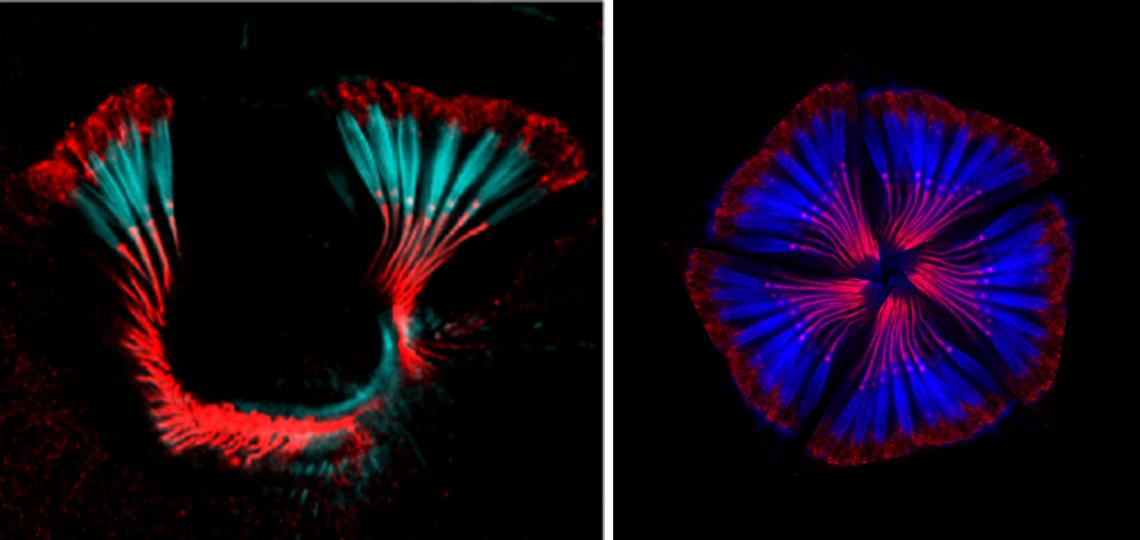
What can Insects Tell us About Hearing in Mammals?
Although the organs and cells that mediate hearing in vertebrates and Drosophila appear to be very different from a morphological perspective, they share a striking evolutionary conservation of molecular and functional properties. We believe that finding new hearing mutants in Drosophila may help identify mammalian genes that regulate hair cell development and function.
How does Drosophila hear? Displacement of air particles (for example, from a rhythmically beating wing during courtship) causes a deflection of the third segment of the fly antenna and its featherlike arista. Rotation of the third antennal segment stimulates a large mechanoreceptive chordotonal organ – Johnston’s organ – located in the second antennal segment. Johnston’s organ comprises over 200 sensory units or scolopidia, each of which consists of 2-3 mechanosensitive sensory neurons. The dendrites of these neurons are surrounded by a scolopale cell, which provides mechanical rigidity to the scolopidium with an array of actin-rich rods. The scolopale cell anchors the scolopidium to the joint of the third antennal segment by secreting proteins that resemble vertebrate tectorins such as NompA. The scolopale cell also secretes a potassium-rich scolopale fluid – similar to vertebrate endolymph – which bathes the dendrites of the sensory neurons.
Our lab is collaborating with Hugo Bellen’s lab at Baylor College of Medicine to combine the use of Drosophila and vertebrates to identify new genes responsible for hearing and deafness. We carried out a pilot screen for Drosophila hearing organ mutants, with the goal of testing whether mammalian homologues of these genes also play a role in hearing. This screen identified over 40 genes involved in the development or function of Johnston’s organ. We focused on one gene from our screen, the Ubr3 E3 ubiquitin ligase, that appears regulates the interaction of non-muscle Myosin II with Myosin VIIa. This is striking because both human variants of both myosins can cause hearing loss. For example, human Myosin VIIa can cause Usher syndrome, the most common form of deaf-blindness. We are now trying to find the targets of Ubr3 and to understand how it regulates myosin function. We are also generating conditional mouse mutants of Ubr3, as this gene has a fascinating expression pattern – it is expressed in every sensory organ in the mouse (ear, eye, taste buds, olfactory epithelium and touch receptors) as well as in parts of the brain that process these sensory modalities, such as the piriform cortex.
Finally we are continuing our collaboration with the Bellen lab to screen several thousand new fly lines in which GFP has been inserted into fly genes known to have human homologues. By screening for expression of GFP in the fly hearing organ, we will identify new candidate hearing genes and can test their function rapidly in Drosophila. In parallel, we are working with the KOMP3 project at Baylor to test 1000 new knockout mouse lines for functional or morphological defects in the inner ear.
Li, T., Giagtzoglou, N., Eberl, D.F., Jaiswal, S.N., Jaiswal, M., Cai., T., Godt, D., Groves, A.K. and Bellen, H.J. (2016). The E3 ligase Ubr3 regulates Usher syndrome and MYH9-related disorder proteins in the auditory organs of Drosophila and mammals. eLife, 10.7554/eLife.15258.
Li, T., Fan, J., Blanco-Sanchez, B., Giagtzoglou, N., Lin, G., Yamamoto, S., Jaiswal, M., Chen, K., Zhang, J., Wei, W., Lewis, M., Groves, A.K. , Westerfield, M., Jia, J., and Bellen, H.J. (2016). Ubr3, a novel modulator of Hh signaling affects the degradation of Costal-2 and Kif7 through poly-ubiquitination. PLoS Genetics, 12(5): e1006054.







